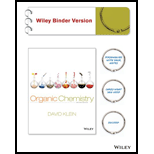
(a)
Interpretation:
The given Imines used to accomplish the target reactant transformation should be draw and identified.
Concept Introduction:
Acid Catalyzed Hydration Reaction: The reaction involves breaking of
Acid-catalyzed is generally applied for the removal of water molecule.
Hydrolysis Reaction: This type of reaction involving the braking of a carbon-carbon triple, double bonds in a molecules using water.
Through acid catalyzed process,
A primary
An imine is a nitrogen analog of an
Formation of imine is reversible and generally takes place with acid or base catalyzed with heat.
Imine formation is typically driven to complete by precipitation of the imine, removal of water or both.
Oxidation Reaction: The oxidation-reduction reaction is a type of
Reagent –It’s a substance or compound added to a system to cause a chemical reaction.
Reactant-It’s a special substance consumed in the course of a chemical reaction to give corresponding product. Reactant always represents in left side and the product must be situated in right side of the reaction.
Product:-Every reaction contains reactant and product and proceeding to give result produt by following certain things.
In a chemical reaction all reaction reactant is denoted in left side and the product is written in right side of the reaction.
A special reactant take part in reaction and give rise to form product in their respective manner.
To identify: The given synthetic route to accomplish the target molecule transformation.
(b)
Interpretation:
The given Imines used to accomplish the target reactant transformation should be draw and identified.
Concept Introduction:
Acid Catalyzed Hydration Reaction: The reaction involves breaking of
Acid-catalyzed is generally applied for the removal of water molecule.
Hydrolysis Reaction: This type of reaction involving the braking of a carbon-carbon triple, double bonds in a molecules using water.
Through acid catalyzed process, ketone gets converted into imine.
A primary amine is an organic derivative of ammonia in which only one ammonia hydrogen is replaced by an alkyl or aryl group.
An imine is a nitrogen analog of an aldehyde or ketone in which the Carbonyl
Formation of imine is reversible and generally takes place with acid or base catalyzed with heat.
Imine formation is typically driven to complete by precipitation of the imine, removal of water or both.
Oxidation Reaction: The oxidation-reduction reaction is a type of chemical reaction it is involves a transfer of electrons between two species. In other words oxidation reaction number of a molecule atom or ion changes by gaining or losing electrons.
Reagent –It’s a substance or compound added to a system to cause a chemical reaction.
Reactant-It’s a special substance consumed in the course of a chemical reaction to give corresponding product. Reactant always represents in left side and the product must be situated in right side of the reaction.
Product:-Every reaction contains reactant and product and proceeding to give result produt by following certain things.
In a chemical reaction all reaction reactant is denoted in left side and the product is written in right side of the reaction.
A special reactant take part in reaction and give rise to form product in their respective manner.
To identify: The given synthetic route to accomplish the target molecule transformation.
(c)
Interpretation:
The given Imines used to accomplish the target reactant transformation should be draw and identified.
Concept Introduction:
Acid Catalyzed Hydration Reaction: The reaction involves breaking of
Acid-catalyzed is generally applied for the removal of water molecule.
Hydrolysis Reaction: This type of reaction involving the braking of a carbon-carbon triple, double bonds in a molecules using water.
Through acid catalyzed process, ketone gets converted into imine.
A primary amine is an organic derivative of ammonia in which only one ammonia hydrogen is replaced by an alkyl or aryl group.
An imine is a nitrogen analog of an aldehyde or ketone in which the Carbonyl
Formation of imine is reversible and generally takes place with acid or base catalyzed with heat.
Imine formation is typically driven to complete by precipitation of the imine, removal of water or both.
Oxidation Reaction: The oxidation-reduction reaction is a type of chemical reaction it is involves a transfer of electrons between two species. In other words oxidation reaction number of a molecule atom or ion changes by gaining or losing electrons.
Reagent –It’s a substance or compound added to a system to cause a chemical reaction.
Reactant-It’s a special substance consumed in the course of a chemical reaction to give corresponding product. Reactant always represents in left side and the product must be situated in right side of the reaction.
Product:-Every reaction contains reactant and product and proceeding to give result produt by following certain things.
In a chemical reaction all reaction reactant is denoted in left side and the product is written in right side of the reaction.
A special reactant take part in reaction and give rise to form product in their respective manner.
To identify: The given synthetic route to accomplish the target molecule transformation.
Want to see the full answer?
Check out a sample textbook solution
Chapter 20 Solutions
Organic Chemistry, Binder Ready Version
 ChemistryChemistryISBN:9781305957404Author:Steven S. Zumdahl, Susan A. Zumdahl, Donald J. DeCostePublisher:Cengage Learning
ChemistryChemistryISBN:9781305957404Author:Steven S. Zumdahl, Susan A. Zumdahl, Donald J. DeCostePublisher:Cengage Learning ChemistryChemistryISBN:9781259911156Author:Raymond Chang Dr., Jason Overby ProfessorPublisher:McGraw-Hill Education
ChemistryChemistryISBN:9781259911156Author:Raymond Chang Dr., Jason Overby ProfessorPublisher:McGraw-Hill Education Principles of Instrumental AnalysisChemistryISBN:9781305577213Author:Douglas A. Skoog, F. James Holler, Stanley R. CrouchPublisher:Cengage Learning
Principles of Instrumental AnalysisChemistryISBN:9781305577213Author:Douglas A. Skoog, F. James Holler, Stanley R. CrouchPublisher:Cengage Learning Organic ChemistryChemistryISBN:9780078021558Author:Janice Gorzynski Smith Dr.Publisher:McGraw-Hill Education
Organic ChemistryChemistryISBN:9780078021558Author:Janice Gorzynski Smith Dr.Publisher:McGraw-Hill Education Chemistry: Principles and ReactionsChemistryISBN:9781305079373Author:William L. Masterton, Cecile N. HurleyPublisher:Cengage Learning
Chemistry: Principles and ReactionsChemistryISBN:9781305079373Author:William L. Masterton, Cecile N. HurleyPublisher:Cengage Learning Elementary Principles of Chemical Processes, Bind...ChemistryISBN:9781118431221Author:Richard M. Felder, Ronald W. Rousseau, Lisa G. BullardPublisher:WILEY
Elementary Principles of Chemical Processes, Bind...ChemistryISBN:9781118431221Author:Richard M. Felder, Ronald W. Rousseau, Lisa G. BullardPublisher:WILEY





